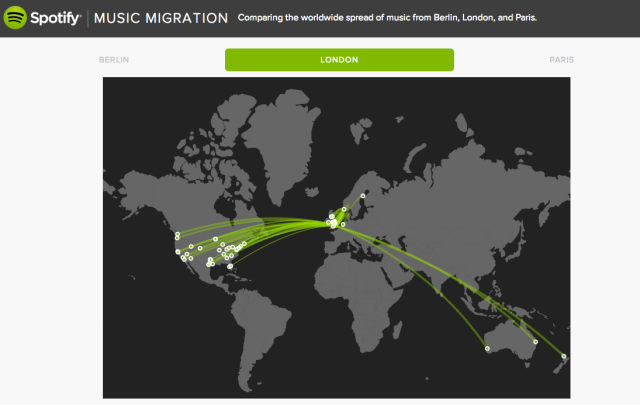
A music-streaming site is probably the last place you’d expect to encounter a video ad. But that’s not stopping Spotify from getting in on the game.
The music-streaming giant announced two new video ad products Monday: “sponsored sessions,” an opt-in offering that enables Spotify’s mobile listeners to play a branded video for 30 minutes of ad-free listening, and “video takeovers,” which run branded videos between songs on the desktop app.
While Spotify has over 10 million paying subscribers, there are another 30 million active users who don’t pay for the service. Advertising to those folks is a major part of Spotify’s revenue stream. The problem: The audio and display ads Spotify has been serving generate far less than video. U.S. advertisers alone are on track to spend $5.96 billion on digital video this year, with $1.44 billion going to ads served on smartphones and tablets, eMarketer estimates.
Spotify wants a piece of that spend, so it’s been cooking up a video ad strategy for around a year, said Brian Benedik, the company’s vp of advertising for North America. It didn’t take long for the company to realize pre-roll ads were not the right fit for its service.
“A lot of publishers go about video with pre-roll and endless video ads, but for us, you’ve got to step back and remember that users are on Spotify for over two hours a day,” Benedik told Digiday. “That gives us a pretty cool canvas to try different things for our users. I don’t think other publishers have that benefit.”
Despite that enviable engagement — the average user spends 84 minutes per day on the service — Spotify faces a challenge most other publishers don’t: Spotify users don’t actually look at the service as they use it. For now, at least, the content is all audio (a Spotify rep declined to comment on the company’s future video content plans).
Spotify guarantees advertisers will only pay for video ads that play to completion. It can even prevent video ads from running on desktop when the player is minimized, queuing up an audio ad instead. But the company cannot promise that people are actually watching.
Ad position: web_incontent_pos1
“I’m not sure if we’ve got that figured out 100 percent,” admitted Benedik, referring to video ad consumption on desktop. “If you can build something either that is heavy in audio in a video format or something that is so compelling that it feels like content even though it’s an ad, that’s the sweet spot we’re trying to find.”
Advertisers aren’t keen to build or modify their creative work for individual platforms, though, noted Forrester analyst Jim Nail.
“If the advertiser has to spend more production money to customize the ad just for Spotify in some way, that’s a huge deterrent,” he said.
On mobile, Spotify listeners actively launch video ads themselves, so in theory they’re more likely to see that content. They’re given some incentive: watching a 15- to 30-second spot will earn them a 30-minute ad-free “sponsored session.”
“What’s very interesting is that there’s always been an implicit value exchange in advertising, in that you get this music for free because the advertising was there. But it was implicit,” said Nail. “Now that’s really becoming very explicit. It’s a subtle but a very important shift in how marketing and consumers interact around advertising and content.”
Ad position: web_incontent_pos2
Spotify plans to launch its two video ad units on Oct. 1 with several launch advertisers, including McDonald’s, Kraft, Coca-Cola, and Universal. Nail isn’t surprised to see a strong launch lineup of companies testing out the service, but those advertisers will need to see consistent results to keep serving pricey video ads on Spotify.
“Quite frankly, unless they get some kind of assurance that the majority of people will see the ad,” he said, “they won’t come back back a second time.”
More in Media

NewFronts Briefing: Samsung, Condé Nast, Roku focus presentations on new ad formats and category-specific inventory
Day two of IAB’s NewFronts featured presentations from Samsung, Condé Nast and Roku, highlighting new partnerships, ad formats and inventory, as well as new AI capabilities.

The Athletic to raise ad prices as it paces to hit 3 million newsletter subscribers
The New York Times’ sports site The Athletic is about to hit 3 million total newsletter subscribers. It plans to raise ad prices as as a result of this nearly 20% year over year increase.

NewFronts Briefing: Google, Vizio and news publishers pitch marketers with new ad offerings and range of content categories
Day one of the 2024 IAB NewFronts featured presentations from Google and Vizio, as well as a spotlight on news publishers.
Ad position: web_bfu